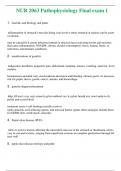NUR 2063 Pathophysiology Final exam 1
1. Gastritis and Etiology and patho
inflammation of stomach's mucolas lining (can involve entire stomach or region) can be acute
or chronic.
may be caused by h. pylori infection (imbeds in mucosal layer activating toxins and enzymes
that cause inflammation. NSAIDS, chronic alcohol consumption, stress, trauma, burns, or
infections, autoimmune conditions
2. manifestations of gastritis
indigestion, heartburn, epigastric pain, abdominal cramping, nausea, vomiting, anorexia, fever,
malaise.
hematemesis and dark, tarry stools indicate ulceration and bleeding. chronic gastri- tis increases
risk for peptic ulcers, gastric cancer, anemia, and hemorrhage.
3. gastritis diagnosis/treatment
h&p, GI tract x ray, egd, serum h. pylori antibod- ies, h. pylori breath test, stool analysis (h.
pylori and occult blood
treatment-acute is self limiting ususally resolves
meds-antacids, acid-reducing agents, and mucosal barrier agents other strategies include those
for GERD (diet, small meals, antacids)
4. Peptic ulcer disease (PUD)
refers to erosive lesions affecting the muscularis mucosa of the stomach or duodenum. ulcers
vary in size and severity, ranging from superficial erosions to complete penetration through GI
tract wall
5. peptic ulcer disease etiology and patho
,ETIOLOGY
most commonly H. pylori and NSAID use.
PATHO
develops because of an imbalance between destructive forces and protective mechanisms
6. PUD duodenal ulcers
most commonly associated with excessive acid or H. pylori infections
typically present with epigastric pain relieved in the presence of food
7. PUD gastric ulcers
less frequent-more deadly typically associated with malignancy and NSAIDS pain worsens
with eating
8. PUD Stress ulcers
develop because of major physiological stressor on body due to local tissue ischemia, tissue
acidosis, bile salts entering stomach, and decreased GI motility
most frequently develop in stomach; multiple ulcers can form within hours of the precipitating
event
often hemorrhage is the first indication (vomiting blood or blood in stool)
9. PUD manifestations/treatment
epigastric, abd. pain, abd. cramping, heartburn, indigestion, chest pain, nausea/voimiting, melena
(dark, tarry stools), fatigue, unexplained weight loss
Treatment
same as gastritis
,antacids, mucosal barrier agents, acid-reducing agents possible surgical repair
10. Iron-deficiency Anemia
Not enough iron for hemoglobin production erythrocytes pale and small
Etiology
decreased iron consumption/absorption, increased bleeding manifestations in addition to
"anemia"
brittle nails, headache/irritability, pica, cyanosis of sclera of eyes, delayed healing
11. Anemia
common acquired or inherited disorder of erythrocytes that impairs the bloods oxygen-carrying
capacity.
ETIOLOGY
decrease in # of circulating erythrocytes, reduction in hemoglobin content, presence of
abnormal hemoglobin
MANIFESTATIONS
weakness, fatigue, pallor, syncope, dyspnea, tachycardia
12. Pernicious anemia
B12 deficiency or megaloblastic anemia large, immature erythrocytes.
usually lack of intrinsic factor (protein necessary for b12 absorption in stomach) b12 is needed
, for cell division and maturity.
too little b12 gradually causes neuro problems because of the breakdown in myelin, neuro effects
may be seen before anemia is diagnosed.
Additional manifestations
bleeding gums, diarrhea, impaired smell, DTR loss, anorexia, personality/memory changes, +
babinski sign, stomatitis, paresthesia of hands and feet, unsteady gait
13. aplastic anemia
bone marrow fails to make enough blood cells leading to pancytopenia
MANIFESTATIONS
general anemia, leukcytopenia, and recurrent infections can be caused by cancers, cancer
treatment, pesticides
14. Sickle cell anemia
genetic, hemoglobin-s trait vs. gene
crescent shape during times of hypoxia, can clump together and clog vessels.
MANIFESTATIONS
swelling in hands and feet, sickle cell crisis, abd. pain, bone pain, jaundice, skin ulcers, stroke,
chest pain
tissue ischemia and necrosis.
electrophoresis and stem cell transplant may cure
15. thalassemia
genetic, not RBC problem, hemoglobin problem. lack one or 2 proteins that make up
hemoglobin
MANIFESTATIONS




